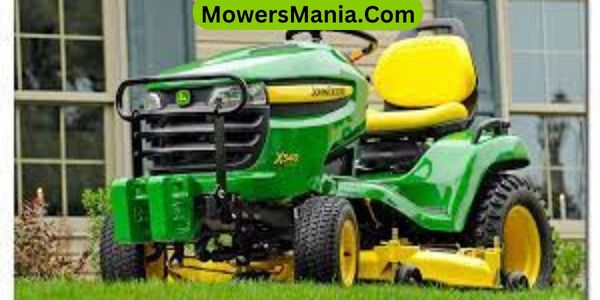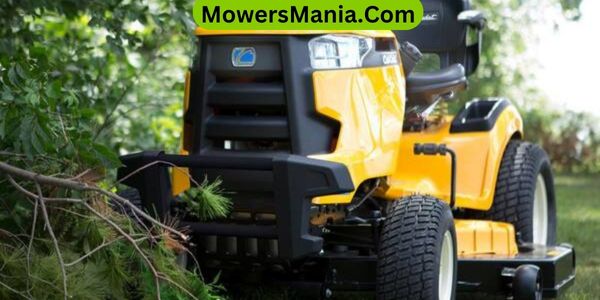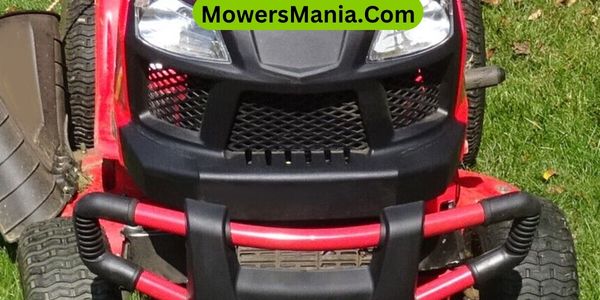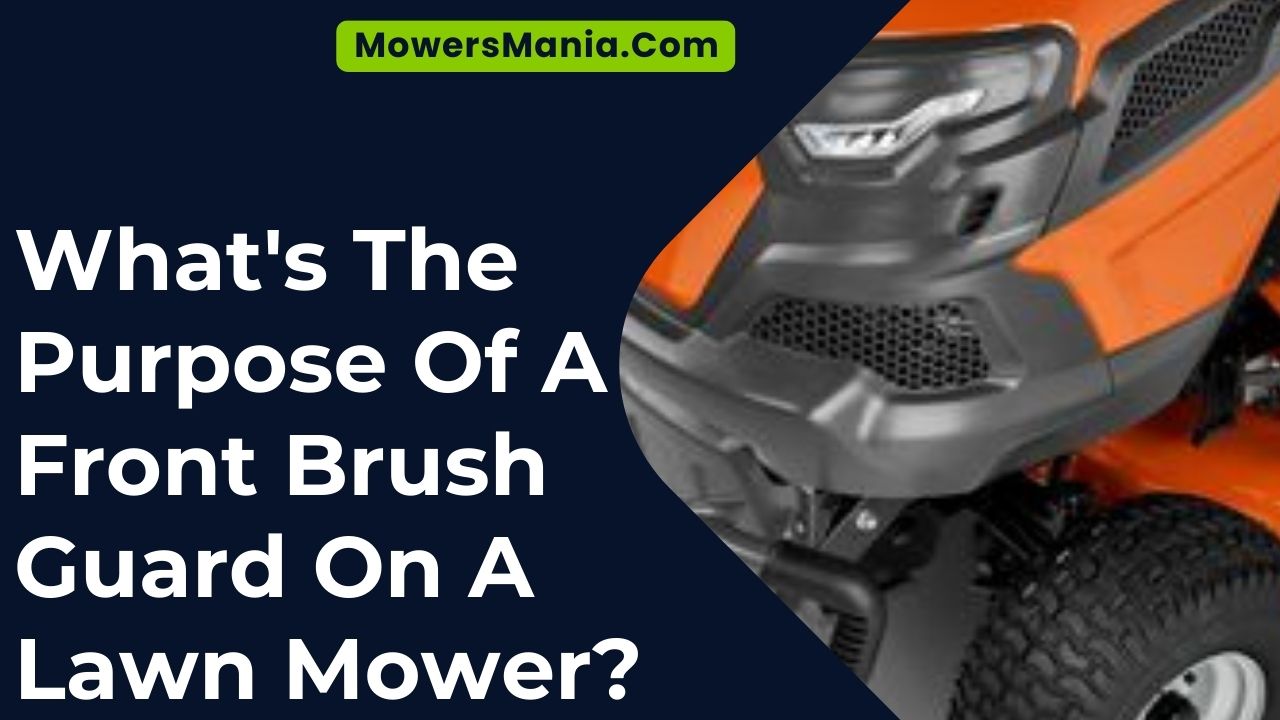You’ve likely seen a front brush guard on a lawn mower, but have you ever wondered why it’s there? The purpose of this seemingly simple addition goes beyond just aesthetics.
It serves a crucial role in ensuring the safety and functionality of your lawn mower, as well as offering protection against various hazards.

But there’s more to it than meets the eye, and understanding its significance can shed light on the importance of this often overlooked component.
Importance of Front Brush Guards
Front brush guards are essential for protecting the front of your lawn mower from damage caused by debris and obstacles.
When you’re mowing, there’s always the risk of rocks, branches, and other objects flying up and hitting the front of your mower.
Without a brush guard, these impacts can cause significant damage to the mower’s delicate components, such as the engine, belts, and pulleys.
By installing a front brush guard, you create a strong barrier that deflects these potential hazards, keeping your mower safe from harm.
Additionally, front brush guards can also help to prevent accidents during mowing. If you accidentally run into a solid obstacle like a tree stump or a large rock, the brush guard can absorb some of the impact and reduce the risk of damage to both the mower and the obstacle.
This not only protects your equipment but also minimizes the potential for injury to you or others nearby.
Protection Against Debris and Objects
When mowing, protecting the front of your lawn mower from debris and objects is crucial to prevent damage and ensure safe operation. The front brush guard serves as a shield, providing essential protection against various hazards encountered during mowing.
Here are three key reasons why protection against debris and objects is essential:
- Prevent Damage: The front brush guard acts as a barrier, deflecting rocks, branches, and other debris that could potentially damage the mower’s vital components, such as the engine, blades, and belts. By minimizing the impact of such objects, the brush guard helps maintain the mower’s functionality and reduces the need for costly repairs.
- Enhance Safety: In addition to safeguarding the mower itself, the brush guard also plays a crucial role in ensuring the operator’s safety. By intercepting flying debris, the guard reduces the risk of injuries caused by objects being thrown out from under the mower, protecting both the operator and bystanders.
- Preserve Aesthetics: The front brush guard helps preserve the overall appearance of the mower by preventing scratches, dents, and other cosmetic damage that can result from collisions with debris and objects. This not only maintains the mower’s visual appeal but also contributes to its overall resale value.
Safeguarding the Mower’s Vital Components

To safeguard the vital components of your mower, the front brush guard acts as a protective barrier, deflecting potential damage from rocks, branches, and debris encountered during mowing.
By installing a front brush guard, you shield essential parts of the mower such as the engine, blades, and belts from being struck or clogged by foreign objects.
This proactive measure helps to prevent costly repairs and downtime, ensuring that your mower remains in optimal working condition.
| Vital Components | Protection Provided |
|---|---|
| Engine | Guards against impact damage |
| Blades | Prevents obstruction from debris |
| Belts | Shields from potential entanglement |
| Steering Mechanism | Protects from impacts and jolts |
| Electrical Wiring | Minimizes risk of damage from debris |
As depicted in the table, the front brush guard serves as a crucial defense mechanism for safeguarding the mower’s vital components. It offers protection against a range of potential hazards, maintaining the integrity and functionality of the mower.
By investing in this protective feature, you can prolong the lifespan of your mower and reduce the need for frequent repairs.
Enhancing Operator and Environmental Safety
Enhance operator and environmental safety by equipping your mower with additional protective features. By doing so, you not only prioritize your own well-being but also contribute to the preservation of the surrounding environment.
Here are three key elements to consider in enhancing operator and environmental safety:
- Rollover Protection Structures (ROPS): Installing ROPS on your mower can prevent potential operator injuries in the event of a rollover. These structures provide a protective zone around the operator, reducing the risk of serious accidents and ensuring a safer work environment.
- Environmental Shields: Implementing shields or barriers around the mower’s cutting blades and discharge chute can help contain debris and minimize the dispersion of harmful particles into the environment. This not only protects the operator from flying debris but also reduces the impact of the mower’s operation on the surrounding ecosystem.
- Emergency Shut-Off Features: Equipping your mower with emergency shut-off switches or mechanisms allows the operator to quickly and effectively halt the machine in unforeseen circumstances, preventing potential accidents and promoting a safer work environment for both the operator and the surroundings.
Compatibility and Installation Considerations

Considering the specific make and model of your lawn mower, it’s essential to assess the compatibility and installation requirements for integrating a front brush guard.
Begin by consulting the manufacturer’s guidelines to ensure that the front brush guard is compatible with your lawn mower. Some models may require specific mounting brackets or modifications for proper installation, so it’s crucial to confirm these details beforehand.
Additionally, take precise measurements of the front of your mower to ensure that the brush guard will fit securely without obstructing any essential components or impeding the mower’s functionality.
When it comes to installation, carefully follow the provided instructions to guarantee a proper and secure fit. If you’re unsure about any steps, don’t hesitate to seek assistance from a professional or someone experienced in installing front brush guards.
It’s essential to install the guard firmly and correctly to prevent any potential hazards during operation. Moreover, ensure that the guard doesn’t interfere with the mower’s turning radius or its ability to navigate around obstacles.
Frequently Asked Questions [FAQs]
Can a Front Brush Guard Be Added to Any Type of Lawn Mower, Regardless of Brand or Model?
Yes, you can add a front brush guard to any type of lawn mower, regardless of brand or model. It provides protection for the mower’s front end and helps prevent damage from debris and obstacles.
Are There Any Regulations or Laws Regarding the Use of Front Brush Guards on Lawn Mowers in Certain Areas?
In certain areas, regulations may require specific types of front brush guards on lawn mowers to ensure safety and compliance. Check local laws and regulations before installing a front brush guard to avoid any issues.
How Does the Addition of a Front Brush Guard Affect the Overall Maneuverability and Performance of the Lawn Mower?
Adding a front brush guard to your lawn mower can impact maneuverability and performance. It may provide extra protection but also add weight to the front, potentially affecting how easily you can steer and navigate around obstacles.
Are There Any Additional Maintenance or Upkeep Requirements for a Lawn Mower With a Front Brush Guard Installed?
With a front brush guard installed on your lawn mower, you may need to regularly inspect and clean the guard to ensure it’s free from debris. Additionally, check for any signs of wear and tear to maintain its effectiveness.
Can a Front Brush Guard Be Used in Conjunction With Other Attachments or Accessories on a Lawn Mower, Such as Bagging Systems or Snow Plows?
Yes, a front brush guard can be used in conjunction with other attachments or accessories on a lawn mower, such as bagging systems or snow plows. It provides added protection and helps prevent damage.
Conclusion
So, if you want to keep your lawn mower safe from debris and objects, protect its vital components, and enhance safety for both the operator and the environment, a front brush guard is a must-have accessory.
Make sure to consider compatibility and proper installation to ensure maximum effectiveness.
Happy mowing!



